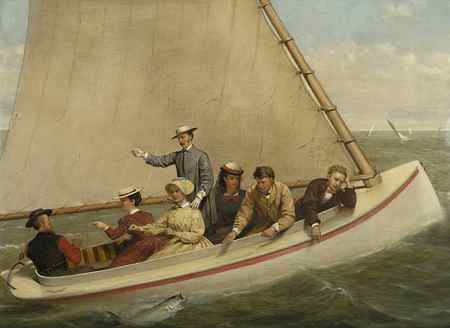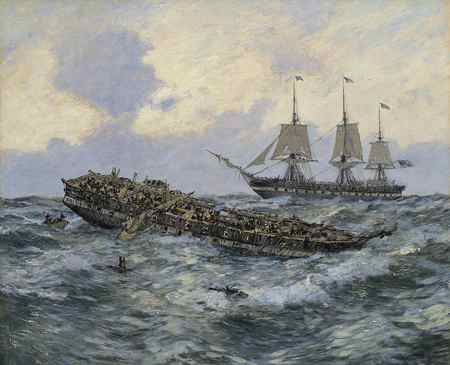Editor's note: The New-York Historical Society
provided source material to Resource Library for the following article.
If you have questions or comments regarding the source material, please
contact the New-York Historical Society directly through either this phone
number or web address:
The Coast & the Sea:
Marine and Maritime Art in America
On view through January 25
- March 9, 2014 at The Society of the Four Arts
The Society of the
Four Arts is the first museum to mount The Coast & the Sea: Marine
and Maritime Art in America -- a new traveling exhibition  highlighting the New-York Historical Society's diverse holdings
of marine and maritime artworks and artifacts. The exhibition is part of
the New-York Historical Society's robust international outreach initiative,
Sharing a National Treasure: The Linda S. Ferber Traveling Exhibition
Program. (right: Thomas Buttersworth (1768-1842), Escape of
the H.M.S. Belvidera From the U.S. Frigate President, ca. 1813-14, oil
on canvas. New-York Historical Society, Bequest of Irving S. Olds, 1963.58)
highlighting the New-York Historical Society's diverse holdings
of marine and maritime artworks and artifacts. The exhibition is part of
the New-York Historical Society's robust international outreach initiative,
Sharing a National Treasure: The Linda S. Ferber Traveling Exhibition
Program. (right: Thomas Buttersworth (1768-1842), Escape of
the H.M.S. Belvidera From the U.S. Frigate President, ca. 1813-14, oil
on canvas. New-York Historical Society, Bequest of Irving S. Olds, 1963.58)
On view through March 9, 2014, the exhibition features
more than 60 of the most important American marine paintings and artifacts
New-York Historical's large and impressive collections. The paintings, ranging
in date from 1750 to 1904, are by eminent artists such as Thomas Birch,
John Frederick Kensett, J. Francis Silva, and Carlton T. Chapman, among
others. Highlights include spirited paintings of famous sea battles, and
romantic portrayals of ships in storms, as well as portraits of naval heroes
and pioneering merchants, like the aptly named Preserved Fish of New
York.
Maritime artifacts include elaborately engraved whale's
tooth scrimshaw from the mid-19th century, a mariner's octant from 1840,
and a handsome silver presentation tureen commemorating acts of bravery during
the War of 1812.
Other features include paintings executed by 19th-century
Chinese artists working in the European style portraying the harbors at
Canton and Hong Kong, as well as the portrait of a clipper ship captain. There
are views of the Hudson River (actually an estuary of the Atlantic) and
the bustling Port of New York, as well as works reflecting Gilded Age nostalgia
for the great age of sail and featuring the legendary naval frigate USS
Constitution, known as "Old Ironsides."
The exhibition is accompanied by catalog, The Coast
& the Sea: Marine and Maritime Art in America, by Linda S. Ferber.
Published by the New-York Historical Society in association with D Giles
Limited, London, the fully illustrated catalog contains104 pages. Linda
S. Ferber, Ph.D., is Senior Art Historian, Museum Director Emerita at the
New-York Historical Society
The Coast & the Sea: Marine and Maritime Art in
America will be on view at the Baker Museum (Naples,
FL) April 19-July 6, 2014.

(above: Junius Brutus Stearns (1810-85), Fishing in a
Catboat in Great South Bay, 1871, oil on canvas. New-York Historical
Society, Gift of C. Otto von Kienbusch, 1964.21)
Wall text panels from the exhibition
- THE COAST & THE SEA: AMERICA'S MARITIME FRONTIER
-
- Since the earliest voyages of exploration that form the
nation's primary foundation myth, the destiny of the United States has
always been linked to the oceanic world. From the time of the earliest
settlement, great harbors have been the source of commercial wealth and
port cities the settings for cosmopolitan ideas.
-
- Wealth generated by maritime enterprises also supported
the nation's cultural development, prompting the rise of schools of marine
and landscape painting as well as portraiture. It is also interesting to
note that a number of the artists represented in this exhibition were themselves
mariners at one time.
-
- The venerable collections of marine paintings and maritime
artifacts at the New-York Historical Society are a reflection of this early
history and culture. This landmark exhibition and accompanying publication
are drawn from these deep holdings to introduce an important body of paintings
and objects, many of which will be new to visitors.
-
- The Coast & the Sea: Marine and Maritime Art in
America is part of the N-YHS traveling exhibition
program, "Sharing a National Treasure." The exhibition
and publication are supported by the New York Community Trust Joanne Witty
and Eugene Keilin Fund, Irma R. Rappaport, and the Thomas and Diane Jacobsen
Foundation.
-
-
- FROM COLONY TO NATION: THE ANGLO-DUTCH TRADITION
-
- These paintings ranging in date from 1750 to 1904 allow
us to explore the rich visual traditions of both marine and maritime painting
and, in the process, demonstrate the often permeable boundaries that marry
rather than separate them. The maritime tradition places emphasis
on documenting seafaring enterprises on the shore or at sea as sites for
human activity. In contrast, the marine painting (or seascape)
focuses on subjects in which the coastal and oceanic environment itself
takes center stage.
-
- Both of these visual conventions had been largely invented
in seventeenth-century Holland. Expatriate Dutch maritime masters in turn
later founded a British school of marine painting that was also transmitted
to England's colonies in North America. After the Revolution, these conventions
would flourish, inspiring works by academically trained artists as well
as those working in vernacular traditions, be they sea painters or portrait
painters.
-
-
- A SECOND WAR OF AMERICAN INDEPENDENCE: THE WAR OF
1812
-
- After the Revolutionary War, American coasts and shipping
were protected by the fleet of a newly established United States Navy.
Vessels carrying names like United States and Constitution
inspired national pride. Harbor defenses in major port cities protected
the nation's maritime frontier, especially from 1812 to 1815, when the
United States again contested British power during the War of 1812. These
massive military structures were depicted in prints and paintings as patriotic
landmarks.
-
- Many battles during America's so-called Second War of
Independence were fought at sea, greatly stimulating the production of
marine painting in both countries. A new generation of heroes joined the
founding fathers and patriots of the Revolution in the American portrait
pantheon. Likenesses of heroes, their ships, and their battles were often
replicated in popular prints and on ceramics (and snuffboxes); their victories
were commemorated in ceremonial silver vessels.
-
-
- ADVENTURE AND ENTERPRISE: THE ROMANTIC SEASCAPE &
THE MARITIME PORTRAIT
-
- Dramatic paintings of shipwrecks and storms at sea offered
powerful subjects for romantic seascapes in the sublime mode. There, the
adversary was nature, and shipwreck served as a universal symbol of life's
trials and vicissitudes. The vessel in stormy seas is the actor in a marine
theater engaged in a battle again weather, waves, and looming rocks. These
create a threatening yet thrilling environment that epitomizes the sublime
in which the fate of the vessel (and those aboard) is uncertain.
-
- The pervasive theme of shipwreck also mirrored the awful
reality of frequent disasters at sea. Spectacular shipwrecks were international
news by the early nineteenth century. Beginning in the 1850s, the United
States Mint struck medals to recognize those who saved the lives of shipwrecked
passengers and the mariners whose lives and livings depended on the sea.
Vocational portraits of those in the maritime world often included views
of their ships as well as the instruments that signaled their callings
as merchants, ship captains, and explorers.
-
-
- THE GREAT ESTUARY: A CITY IN THE "ARMS OF THE
SEA"
-
- The vast coastal environs of New York Harbor presented
infinite opportunities for artists to portray inland waterways that were
alternately maritime and terrestrial. In fact, those waterways were literally
"arms of the sea" that had swallowed the ancient Hudson River
thousands of years before, when glaciers melted and the sea level rose,
flooding the prehistoric coastal plain. In the process, one of the world's
great natural harbors was formed, as was the estuary that we know today
as the Hudson River, which carries the Atlantic's tides some 153 miles
into the interior.
-
- Such rich permutations of seascape and landscape have
inspired printmakers, painters, and poets for more than two hundred years.
The historic sites and varied scenery along the Hudson were co-opted into
a landscape vision of national patrimony. The unique setting of the city
at the river's mouth offered artists opportunities to combine seemingly
endless configurations of land and sea, city and ships.
-
-
- LEISURE AND LIGHT: PAINTINGS OF SEASIDE AND PORT
-
- The second generation of Hudson River School painters
added coastal subjects to their repertoires and summer sketching itineraries,
trekking all along the eastern coast from New Jersey to New England. Traditional
picturesque touring routes were expanded to include the seaboard, reflecting
modern trends of tourism, as old colonial ports were reinvented as quaint
resorts for the urban populations of Boston, Philadelphia, and New York.
-
- As tourism boomed in the second half of the nineteenth
century, maritime specialists added popular seaside recreations to their
list of subjects. Sailing was embraced as a leisure activity and a sport.
These paintings also reflect artists' growing interest in light as an expressive
medium, demonstrated in the brilliance with which many capture the fleeting
effects of weather and time of day to create poetic waterscapes.
-
-
- GILDED AGE NOSTALGIA: REMEMBERING THE GREAT AGE OF
SAIL
-
- Gilded Age nostalgia during the 1880s and 1890s inspired
commissions to depict historic naval battles of the War of 1812 and the
Civil War. In addition, beginning with the United States Centennial in
1876, a series of national commemorations expressed a collective nostalgia.
These public displays were powerful cultural and political agents for rebuilding
a national fabric after the rupture of the Civil War and Reconstruction.
National commemorations of Columbus's voyage in 1892 and 1893, along with
the United States Navy centennial in 1894, turned American eyes back to
the Atlantic.
-
- These observances generated widespread interest in history.
Popular sentiments were driven by the nation's increasing industrialization,
most in the maritime realm by the dominance of steam, iron, and steel over
wood and sail. All converged to stimulate the writing of histories in books
and magazines, whose publishers enlisted the talents of the finest American
painter-illustrators to re-create major events in maritime military history.

(above: Carlton Theodore Chapman (1860-1925), Engagement
Between the U.S. Frigate Constitution and H.M.S. Guerriere, 1895, oil
on canvas. New-York Historical Society, The Naval History Society Collection
(John Sanford Barnes Foundation), 1925.113)
Resource Library editor's
note
RL readers may also enjoy:
For further biographical information on certain artists
cited above please see America's Distinguished
Artists, a national registry of historic artists.
Read more information, articles and essays concerning this
institutional source by visiting the sub-index page for the New-York
Historical Society in Resource Library.
Search Resource
Library for thousands of articles and essays on American art.
Copyright 2014 Traditional Fine Arts Organization, Inc., an Arizona nonprofit corporation. All rights
reserved.
 highlighting the New-York Historical Society's diverse holdings
of marine and maritime artworks and artifacts. The exhibition is part of
the New-York Historical Society's robust international outreach initiative,
Sharing a National Treasure: The Linda S. Ferber Traveling Exhibition
Program. (right: Thomas Buttersworth (1768-1842), Escape of
the H.M.S. Belvidera From the U.S. Frigate President, ca. 1813-14, oil
on canvas. New-York Historical Society, Bequest of Irving S. Olds, 1963.58)
highlighting the New-York Historical Society's diverse holdings
of marine and maritime artworks and artifacts. The exhibition is part of
the New-York Historical Society's robust international outreach initiative,
Sharing a National Treasure: The Linda S. Ferber Traveling Exhibition
Program. (right: Thomas Buttersworth (1768-1842), Escape of
the H.M.S. Belvidera From the U.S. Frigate President, ca. 1813-14, oil
on canvas. New-York Historical Society, Bequest of Irving S. Olds, 1963.58)
